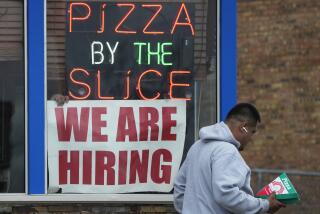Job growth fuels optimism about U.S. recovery
WASHINGTON — Fears of a recession seemed to evaporate as the nation added 157,000 net jobs last month and other key economic data improved, boosting major stocks to their highest level in more than five years.
Economists and investors were heartened by the Labor Department’s jobs report Friday, which suggested that growth accelerated at the end of last year.
The new economic readings — a mix of federal and private data — contrasted with Wednesday’s government report that the economy contracted at a 0.1% annual rate in the last three months of 2012.
The January jobs report, which also showed the unemployment rate ticked up to 7.9%, came in slightly below analyst expectations. But revised job growth figures dating to early 2011 triggered a surge of optimism that the recovery had not veered off track.
“The economy’s the little engine that could,” said JJ Kinahan, chief derivatives strategist for TD Ameritrade. “It’s slowly climbing.”
The Dow Jones industrial average shot up nearly 150 points, closing above 14,000 for the first time since 2007. The White House touted the 35th straight month of private-sector job growth.
And analysts pointed to sharp upward revisions by the Labor Department of previous job creation, particularly in the final three months of last year, as proof that the recovery was still moving forward.
The government said there were 422,000 more jobs created than initially reported for the year ended last March 30. And from April through December, the Labor Department revised upward its earlier estimates by 225,000 jobs.
Altogether, that added nearly 650,000 people to the workforce. The new figures mean that on average, the economy added 181,000 jobs each month last year, up from the earlier estimate of 153,000.
In the last three months of the year, the economy averaged 201,000 jobs added, including 247,000 in November and 196,000 in December.
The small shortfall in the fourth quarter’s gross domestic product — the value of all goods and services produced nationwide — marked the first contraction since the Great Recession ended in mid-2009 and raised worries that another downturn was ahead.
Many economists quickly said the report appeared to be an anomaly driven by fears of the so-called fiscal cliff, and Friday’s data gave more credence to that view.
“We had some pretty good job growth in the fourth quarter,” said Stuart Hoffman, chief economist at PNC Financial Services. “You don’t get that kind of job growth if the economy is legitimately flat on its behind.”
Still, he described the January jobs report as mediocre.
Analysts had expected that 165,000 jobs would be added to the economy. The January figure also looked worse in comparison to the revised December figure. The unemployment rate rose from 7.8% in December.
Last month, the private sector added 166,000 jobs, but overall growth was pulled down by a net loss of 9,000 government jobs, the Labor Department said.
Sectors that showed job gains in January included retail, construction and healthcare, while transportation and warehousing declined.
“It’s a bit of an underwhelming report,” said Peter McHenry, an assistant economics professor at the College of William and Mary. “We’ve still got just a very slow recovery — certainly a recovery — but not anything to be really excited about.”
The construction industry added 28,000 jobs in January. Some economists had expected more, given the damage in the Northeast from Superstorm Sandy last fall.
But the increase was “validation the housing market continues to gain momentum,” said Diane Swonk, chief economist at Mesirow Financial.
Since bottoming out in January 2011 after the housing collapse, the construction industry has added 296,000 jobs, the Labor Department said. One-third of that gain came in the last four months.
“A quarter ago, you’d say the housing market had stabilized,” TD Ameritrade’s Kinahan said. “Now you can say the housing market is starting to grow.”
In another positive sign for the sector, the Commerce Department said Friday that construction spending increased 0.9% in December from the previous month, to an annual rate of $885 billion.
The manufacturing sector expanded in January for the second straight month, the Institute for Supply Management said. Jobs in the manufacturing sector have shown little change since the summer, the Labor Department said.
And consumer confidence also improved slightly last month after Washington policymakers avoided most of the tax increases slated to kick in Jan. 1 as part of the “fiscal cliff.”
The closely watched consumer sentiment index from Thomson Reuters and the University of Michigan rose to 73.8 in January from 72.9 the previous month.
One tax change that was not avoided — the expiration of the two-year payroll tax cut — held down consumer confidence, said Richard Curtin, the survey’s chief economist.
The higher payroll tax, which started showing up in paychecks in early January, was a drag on job growth in January, economists said.
More potential problems are looming as Congress must deal with large automatic spending cuts set to hit March 1. And another battle over the nation’s debt limit could be coming this summer after Congress approved a temporary increase to avoid a potential showdown this month.
Swonk said such “fiscal land mines” could derail the recovery.
And Alan Krueger, chairman of the White House Council of Economic Advisors, warned that the jobs report showed “the need for Congress to act to avoid self-inflicted wounds to the economy.”
Still, he said, the report was “further evidence that the U.S. economy is continuing to heal.”
House Speaker John Boehner (R-Ohio), however, said President Obama should not accept “sluggish growth” and needs to work with Congress to find ways to improve growth and reduce the nation’s debt.
Although the nation does not appear headed toward recession again — commonly defined as two straight quarters of contraction — the economy remains fragile, Swonk said.
“The labor market is healing, but unevenly,” she said.
More to Read
Start your day right
Sign up for Essential California for news, features and recommendations from the L.A. Times and beyond in your inbox six days a week.
You may occasionally receive promotional content from the Los Angeles Times.







